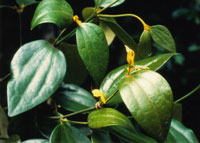Mistletoes - cryptic mimicry
An evolutionary process?
The case for cryptic mimicry can be argued largely on the grounds that the morphological form of the mistletoe has a firm genetic basis, and is not determined or influenced by any physiological interaction such as transfer of growth substances from the host (see below under nutrient metabolism). The form of the mistletoe is therefore the result of natural selection.
Secondly, the resemblance between host and parasite in our open forests cannot be simply due to convergence in leaf structure and function through adaptation to the same environmental conditions (but see box). Similar leaf shape does not always reflect similar leaf function. Mistletoe leaves have a much higher transpiration rate than their hosts, and have a different cycle of stomatal opening and closing. Furthermore, strikingly different leaf forms are found among the mistletoes of one geographical area, just as they are among the hosts.
![An Australian Government Initiative [logo]](/images/austgovt_brown_90px.gif)


